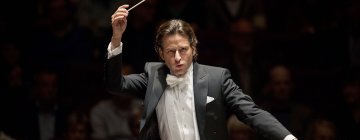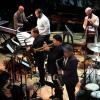Today Monterey, tomorrow the world.
For SFJAZZ, this is an era of expansion in all directions. As the 2025–2026 season kicks off this week with more than 350 shows running through May, the $64 million SFJAZZ Center can no longer contain Terence Blanchard’s vision.
A seemingly boundless figure who’s earned acclaim as a trumpeter, bandleader, educator, and composer of sweeping jazz suites, film scores, and groundbreaking operas, Blanchard brings a similarly expansive sensibility to SFJAZZ. Among American jazz presenters, the organization was already a juggernaut — rivaled only by New York’s Jazz at Lincoln Center when Blanchard took the reins as executive artistic director in June 2023.
Since then, he’s orchestrated a multipronged advance digitally and in person, building on some existing programs while initiating many others. Most visibly, SFJAZZ is forging alliances with other major California jazz institutions, such as San Jose Jazz Summer Fest, where SFJAZZ hosted three days of programming at the Montgomery Theater Stage last month.
From Sept. 26–28, for the first time ever, the organization is partnering with the Monterey Jazz Festival, where the 300-seat Pacific Jazz Café also bears the imprimatur “Presented by SFJAZZ.” And next month brings the inaugural SFJAZZ @ The Lesher Center series in Walnut Creek, opening on Oct. 8 with the Branford Marsalis Quartet.
Of course, the bulk of the action takes place at the SFJAZZ Center, which opened at the beginning of 2013, immediately ushering in a new era as the nation’s first stand-alone venue built specifically to showcase jazz. The new season reflects the organization’s longstanding approach to programming, with a focus on acoustic jazz but encompassing an array of offshoots and kindred traditions.
The coming weeks feature a gospel program with the Blind Boys of Alabama and special guest funk organ star Cory Henry (Sept. 6–7), 88-year-old bass legend Ron Carter’s Foursight Quartet with pianist Renée Rosnes (Sept. 17–20), the SFJAZZ debut of rising alto saxophonist Sarah Hanahan (Sept. 20), and a spectacular Cuban piano double bill pairing the Alfredo Rodríguez Trio and the Dayramir González Quartet (Sept. 27), the season’s first offering in Blanchard’s UpSwing series, designed to fuel the ascent of rising artists.
“The thing I’ve been saying for years, to students, to anyone who will listen, is that there’s no one way to skin this cat,” Blanchard said. “There are a lot of different approaches. A lot of people on the season you wouldn’t think I’d be into, but when I see people who are doing things I think are worthwhile, I think we need to present them.”
On the digital front, SFJAZZ continues to build on Fridays Live, the pandemic-inspired weekly livestreams that bring Miner Auditorium performances to viewers around the world (with Saturday morning encore broadcasts and on-demand access the following week). The expertly produced series launched in 2020 as a vehicle for SFJAZZ to stay connected with fans when the center was shuttered, while also providing income to gig-deprived musicians.
The broadcasts still include an “Artist Fund” button so viewers can give directly to the performers, a feature that has put over $1 million in musicians’ pockets. During the performances, the live chat often pings with comments from fans watching the show around the world, providing a singular group experience that’s distinctly different from the communal pleasures of an in-person concert.
Restarting on Sept. 5 with organist Cory Henry & The Funk Apostles, Fridays Live includes a brilliant cross section of acts gleaned from the nine-month season (“He’s one of those talented dudes, a freak of nature in terms of what he can do,” Blanchard said). Cuban reed star Paquito D’Rivera celebrates seven decades of music-making on Sept. 25–26, and powerhouse Dominican pianist Michel Camilo plays a solo recital on Oct. 3, just for starters.
While Fridays Live has extended SFJAZZ’s reach around the world, Blanchard wants the organization to bring live music to Europe, too. “We want to hit many of the major festivals,” Blanchard said. “When you look at what happens on our stage, it’s a very eclectic mix, and that’s what we want to present. We want to give people around the world a sense of what we’re doing here in San Francisco.”
The personnel pieces have fallen into place to pursue this plan. Last year, well-traveled German-born presenter Burkhard Hopper joined Blanchard’s team as director of artistic programming, bringing with him a wealth of experience putting together packages of young American jazz artists for the European festival circuit.
“Burkhard is very knowledgeable about the music,” Blanchard said. “And when I talked about world domination, he understood what that meant. I want to see SFJAZZ Presents at various other places. There are some great initiatives we’re going to start putting out.”
This year, SFJAZZ lured Gabrielle Armand from Jazz at Lincoln Center, where over the past two decades she spearheaded a wide array of programs, leading teams in marketing, corporate partnerships, audience development, and intellectual property. She also launched the organization’s label, Blue Engine Records. She’s still getting acclimated since taking over from Interim Chief Executive Officer Susie Medak on July 1 as SFJAZZ’s new CEO, and her experience seems ideally aligned with Blanchard’s global vision.
Indeed, as SFJAZZ’s reach expands, one challenge will be maintaining ties to the local scene. Long before Blanchard was brought on to replace SFJAZZ founder Randall Kline, Bay Area jazz artists often described feeling a cold shoulder from the organization. Armand looks at Blanchard’s ongoing commitment to the New Orleans scene as a sign of how he’ll engage with the Bay Area.
Armand recalls that Ellis Marsalis, patriarch of the New Orleans jazz clan, “taught them the notion of community, that things begin at home.” “That’s core. I think there’s always going to be a strong focus on local, homegrown talent. To me, that means more than advocating for musicians. It’s about engaging audiences and building through-lines with our education programs.”
The ambitious plans for the future are taking shape even as SFJAZZ’s past comes into clearer focus. In May, the organization opened access to the SFJAZZ Historical Archive, a vast collection of some 2,000 recordings from the pre-SFJAZZ Center era. Recorded between 1983 and 2012, the trove includes commissioned works, world premieres, panel discussions, pre-concert talks, and interviews, tracking the organization’s evolution from Jazz in the City to the San Francisco Jazz Festival, when concerts took place at venues around the city. The project, a decade-long effort to preserve events documented on cassettes, DATs, VHS, and other analog media, was supported by a grant from the Council on Library and Information Resources (CLIR) with preservation assistance from California Revealed.
The performances and conversations provide an invaluable window into the programmatic DNA that Blanchard inherited, with performances by epochal artists such as drummers Max Roach, Tony Williams, and Elvin Jones, tenor saxophonists Sonny Rollins, Pharoah Sanders, David Murray, and Joe Henderson, and trumpeters Wadada Leo Smith and Don Cherry (almost all of whom are also consequential composers).
If Blanchard’s vision for SFJAZZ stretches to the horizon, he has a deep well of creative fuel to draw on.




